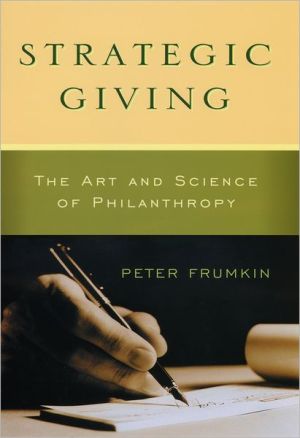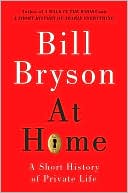Strategic Giving: The Art and Science of Philanthropy
The philanthropic landscape is changing dramatically as a new generation of wealthy donors seeks to leave its mark on the public sphere. Peter Frumkin reveals in Strategic Giving why these donors could benefit from having a comprehensive plan to guide their giving. And with this thoughtful and timely book, he provides the much-needed framework to understand and develop this kind of philanthropic strategy. \ After listening for years to scores of individual and institutional funders...
Search in google:
The philanthropic landscape is changing dramatically as a new generation of wealthy donors seeks to leave its mark on the public sphere. Peter Frumkin reveals in Strategic Giving why these donors could benefit from having a comprehensive plan to guide their giving. And with this thoughtful and timely book, he provides the much-needed framework to understand and develop this kind of philanthropic strategy. After listening for years to scores of individual and institutional funders discuss the challenges of giving wisely, Frumkin argues here that contemporary philanthropy requires a thorough rethinking of its underlying logic. Philanthropy should be seen, he contends, as both a powerful way to meet public needs and a meaningful way to express private beliefs and commitments. He demonstrates that finding a way to simultaneously fulfill both of these functions is crucial to the survival of philanthropy and its potential to support pluralism in society. And he goes on to identify the five essential elements donors must consider when developing a philanthropic strategy—the vehicle through which giving will flow, the way impact will be achieved, the level of engagement and profile sought, the time frame for giving, and the underlying purpose of the gift. Frumkin’s point is that donors must understand strategic giving as the integration of these five critical dimensions to giving. Essential reading for donors, researchers, and anyone involved with the world of philanthropy, Strategic Giving provides a new basis for understanding philanthropic effectiveness and a promising new way for philanthropy to achieve the legitimacy that has at times eluded it. Stanford Social Innovation Review “Peter Frumkin has written an important and provocative book that will be read and debated for years to come. Strategic Giving is both a comprehensive, critical analysis of modern philanthropy and a useful guide for wealthy donors who want to distribute their money to meet public needs as effectively as possible.”—Pablo Eisenberg, Stanford Social Innovation Review— Pablo Eisenberg
Strategic Giving \ The Art and Science of Philanthropy\ \ By Peter Frumkin The University of Chicago Press \ Copyright © 2006 The University of Chicago\ All right reserved.\ ISBN: 978-0-226-26626-8\ \ \ \ Chapter One \ Philanthropy and the Public Sphere\ Private donors may face complex choices relating to how they go about delivering philanthropic funds, but this work hardly occurs in a vacuum. Because it operates across the public and private domains, because it both enacts and expresses, and because it is so difficult to know for sure which grants and contributions produce meaningful results, government has taken a relatively cautious approach to fashioning public policy and regulation around philanthropy. To be sure, there are plenty of procedural guidelines, rules, and regulations bearing on the administration of philanthropic assets. But on the most important substantive issue of all, namely what kinds of causes are to be supported, government has remained silent. It has left the ultimate choice of philanthropic purposes to donors and resisted rendering judgment about the comparative public value realized when private gifts support a vast range of causes and programs. In the face of many gifts that seem misdirected, wrongheaded, and even foolish, the fundamentally sound and correct nature of this permissive policy position requires some explanation.\ Giving and Public Policy\ The tax code defines andreinforces some of the most important categories of nonprofit organizations. It alternatively conveys privileges and imposes regulations on organizations based on their legal status and form. While all nonprofit organizations are exempt from taxation, only some-those that serve the public, not just a restricted membership-receive the added benefit of being able to confer on donors an income tax deduction for their support. The simple principle of tax exemption can be understood as an acknowledgment of the independence and freedom of private action. It allows nonprofits to operate in a way that is fundamentally different from for-profit entities that owe taxes to the state based on the profits they generate. By contrast, nonprofits are allowed to keep any excess revenues and simply apply them to future charitable purposes. The history of the line between government and nonprofits is long and winding, going back centuries in the United States, but its essential course is clear: Federal and state government in the United States accept the desirability of having independent actors in society working for the common good and shield them from taxation so that they can operate without owing government funds in the form of taxes. Beyond the principle of autonomy that tax exemption conveys (even more so for churches, which do not have to file any reports at all), the tax treatment of nonprofits includes a second feature: namely a public subsidy for charitable activity that serves the public in the form of a tax deduction conferred to supporters of nonprofits. This subsidy of nonprofits, given in the form of tax relief to the contributors to nonprofits, is designed to reward those who commit private funds to public purposes. It recognizes that there is a value in private support of charitable work, and it makes giving less expensive than it would be in the absence of a tax deduction for charitable giving. Although there is considerable debate about how efficient this subsidy is and how much giving it actually does encourage, the tax deduction for charitable gifts is still the second critical leg in the public sector's relationship with the nonprofit sector.\ One explanation for the tax code's inclination to support giving is that government sees private philanthropy as a necessary partner in the pursuit of public purposes. The difficulty in setting up a policy that encourages privately financed and directed solutions to public problems is that if taken to its logical conclusion, it raises difficult questions about accountability. By moving public services out of government and forgoing tax revenues in order to encourage the private provision of publicly valued services, government risks introducing both greater inefficiency and inequity into the process of public provision. It is important to examine this issue carefully for within it lies the difficult question of what social function philanthropy should emphasize. Government is left, in effect, with the prospect of subsidizing private philanthropic action carried out for the benefit of the public, with government given little say, beyond the vaguest notion of fulfilling a charitable purpose, over the actual causes that will be supported. This might appear to be a disaster waiting to happen or at least a very inefficient way of accomplishing public purposes.\ The lack of real substantive accountability around ultimate purposes is astounding. Of course, a few areas are forbidden that cannot be construed as anything other than self-serving action and that fail to fall under even the broadest definition of public benefit. For the most part, the range of charitable purposes permitted is as broad as the human mind can imagine. The loose accountability demands of government to qualify for subsidization in the form as a tax deduction do not even apply to all philanthropy. There is much giving that operates independently of the policy regime and that seeks no recognition from it. Still, among donors seeking a deduction, the accountability demands placed on them are weak, particularly when compared to those government places upon itself. When it comes to accountability, government has several time-tested tools it can fall back on. There are elections designed to hold representatives accountable to their constituents. There are often ample opportunities for interested and affected parties to voice their opinion about legislation or regulation before it is acted upon. There are multiple layers of decision making in government that create internal accountability within the process. There is oversight and review that take place after funds are disbursed. And of course, there are auditing and evaluation processes that can be used to maintain accountability all the way through the implementation process. Throughout all these steps, democratic systems are designed to give stakeholders access and voice. In philanthropy almost none of these conditions exist. Private philanthropic funds are largely disbursed with little or no input from the public, and while there are internal accountability systems between donors and trustees and between trustees and staff, the external world is largely left with its nose pressed up against the glass when it comes to the actual substantive work of philanthropy.\ Thus, as one considers the relationship between government and philanthropy, and as the full range of policy approaches comes into focus (ranging from very supportive policies to more neutral or even more negative ones), it is clear that moving responsibility for the provision of public needs from government to philanthropy involves a trade-off of some control in the name of decentralization. Philanthropy simply does not have the controls, safeguards, and accountability devices that government guarantees. By its nature, philanthropy is hard to organize and direct, almost never predictable, subject to the whims of a few, and largely unresponsive to pressures from stakeholders. The one major exception is when government decides to investigate and regulate the administrative side of institutional philanthropy, but, over the past century, such efforts have focused mostly on technical questions related to the management of philanthropic resources and issues related to financial accountability.\ The most difficult question to answer about the accountability issue connected with public support of philanthropy is whether the benefits of this devolution of authority create sufficient benefits to outweigh its costs. One way to think about this cost-benefit calculus is to juxtapose once more the instrumental and expressive purposes in philanthropy, the fact that philanthropy is about both the rational and effective application of resources to address human needs and the passionate enactment of the values, commitments, and beliefs of individuals who have defined a public problem as worthy of private attention. Government could surely craft a more restrictive and directive regulatory and policy regime that would push philanthropy toward a far greater emphasis on its instrumental dimension. By the same token, public policy toward giving could be relaxed even more in ways that would enable and encourage a more expansive, expressive function for giving. In many ways, one's view on how this trade-off between public purposes and private values should be handled through public policy will depend heavily on how one defines the core function of philanthropy, whether its chief role is in the area of social innovation, pluralism, and self-expression, or whether its core rationale resides in redistribution and social change. The amount of freedom and the amount of social responsibility that government vests in philanthropy will ultimately constitute an answer to this question. Given ample support through public policy or constrained considerably by tax law and regulation, philanthropy can be positioned more or less advantageously to fulfill any of its core functions.\ The stakes are high in this delicate balancing act. The lack of social control over ultimate results of philanthropy, which a loose policy grip on philanthropy entails, will unnerve many citizens and be taken to be an acceptance of the power that wealthy donors possess. By not directing giving in any particular direction, public policy runs the risk of failing to take ample advantage of the opportunity to channel large amounts of private wealth from the hands of a relatively small few to those who need assistance the most. At the same time, efforts to control the direction of philanthropy can be threatening to the idea of a vital and independent civil society. Philanthropy is a central part of the engine that drives the nonprofit sector forward, no matter how earned income and government contracts have changed the funding picture. If government through a tightening of the regulation of charitable giving attempted to steer philanthropy toward more universally accepted and instrumental purposes, something very significant would be lost. To have a vital sector of society working to solve pressing problems outside of government is an important element in an open society; it moves power outward and allows philanthropy to question government priorities and approaches to public problems. Public tolerance of some of the inefficiencies of an open and free civil society has a number of interesting parallels to the quandary government faces when it comes to regulating private enterprise and the operation of markets.\ There is a vast and detailed set of theories about why free markets produce beneficial results. From Adam Smith to Milton Friedman, economists have long embraced the view that the freedom to choose and the presence of a way to exchange lead to results that benefit people. At the heart of an economist's appreciation of markets is the belief that competition and consumer sovereignty are great controlling devices that help ensure that the best products at the lowest price reach the market. As producers compete for the attention of consumers, markets move to punish inefficient and low-quality producers, while rewarding those that are able to offer consumers value. The model has been refined and expanded over the centuries but its core assumptions remain fairly constant. The attraction of markets is also enhanced by the prospect that individuals participating in it and acting from self-interest will be led, in Smith's words, by an invisible hand, to decisions and results that benefit society.\ One of the deepest and most intriguing questions about philanthropy is whether donors will be led through a new invisible hand to a set of philanthropic decisions and arrangements that truly benefit the public. If this were the case, then there would be little need for government regulation as donors and causes would quietly find one another and maximize social welfare in the process. This optimistic perspective on philanthropy would argue against much government intervention, regulation, or subsidization of particular causes, believing that donors freely pursuing their own philanthropic interests with passion and conviction will lead in aggregate to the funding of projects that reflect both the interests of donors and the needs of the public. On this view, the unfettered pursuit of personal philanthropic interests is the best mechanism for both arriving at broad social results that are optimal and giving that produces the most possible psychic satisfaction for donors. Each part of this kind of claim about the sound functioning of philanthropic markets-the maximization of social welfare and the fulfillment of donors-needs to be examined carefully, because consumption and production in philanthropy are complicated concepts.\ The first part of this puzzle is relatively straightforward. It is entirely plausible to hold that donors will be able to maximize their own satisfaction when they have total control over the targets of their generosity. Without regulations favoring one type of giving over another, philanthropic funds will flow to causes that resonate most with donors and that satisfy their philanthropic goals most fully. Donors will select charities and causes that allow them to get meaning and satisfaction. Looking within at their values, beliefs, and personal experiences, donors will direct their giving in ways that make them feel good about supporting the cause that is supported, be it simply because they like what the organizations represent or because they get pleasure from knowing that their giving might make a real difference. Philanthropy is a form of consumption in that it produces, in all its guises, forms, and styles, a sense of satisfaction in having done something for others. To the extent that donor choices are not constrained by outside forces, those who give are able to follow their most basic impulse to help in ways that are meaningful to them.\ The other side of the problem-the side associated with public benefits-is far less obvious. After all, there is no clear evidence that the maximization of psychic satisfaction in giving will in turn maximize the public benefits that result from giving. This proposition can be softened a bit and turned into a question: how well does the freedom to give exercised by donors translate into value for society? When the productive side of giving is scrutinized and opposed to its consumptive side, it is ultimately very difficult to sustain the argument that philanthropy has the same characteristics as markets. There is at least one major force missing from philanthropy that might drive donors to maximize public benefits: competition. While there is some pride associated with funding successful and visible programs, donors do not compete in order to stay in the field of philanthropy. Ineffective donors who have chosen to give in areas that no one else believes are significant are never required to change direction. Donors that give to poorly run nonprofit organizations are never forced to relinquish their charitable assets. Donors that give so many small grants that nothing of consequence ever results from their giving are not cited and regulated out of business. Indeed, ineffectiveness is not only excused in philanthropy, it is accepted as an occupational hazard. The institutional structure of the field is geared to ensuring perpetual life regardless of the results that are achieved. There is thus no threat of demise or pressure from other donors that can drive poorly performing donors out of the field. Donors are welcomed with open arms indefinitely. Even if there were competition among donors, it is not clear how winners and losers could be sorted out given the immense obstacles to measuring performance. Thus, while it would be comforting to think that donors are part of a tightly structured market that drives them through invisible pressures to give grants that maximize the utility of others, there are too many real and conceptual obstacles to ever making the free market analogy apply compellingly.\ Not only is there no real competition for profit or survival, but there is also no certainty that the private perspectives of donors will actually match the demand for charitable services in the aggregate. There are few clear mechanisms other than overt human suffering to draw philanthropists into areas that have been neglected. And this is a process, especially when dealing with issues such as urban neighborhood decline, that can take long periods of time to work itself out. In this sense, the response of donors to "demand" is not immediate or even assured, given the amount of public need that goes unattended simply because of the inadequacy of philanthropic resources. Beyond the lack of an active and accurate pull from the consumers of philanthropy on the supply of charitable dollars, there are other conceptual problems in the application of a market metaphor to philanthropy. Still, no matter how weak the case is for a philanthropic invisible hand, the arguments for regulation and state intervention in giving are even weaker and less compelling.\ (Continues...)\ \ \ \ \ Excerpted from Strategic Giving by Peter Frumkin Copyright © 2006 by The University of Chicago. Excerpted by permission.\ All rights reserved. No part of this excerpt may be reproduced or reprinted without permission in writing from the publisher.\ Excerpts are provided by Dial-A-Book Inc. solely for the personal use of visitors to this web site. \ \
1Philanthropy and the public sphere292Central problems in philanthropy : effectiveness, accountability, and legitimacy553Donors and professionals904The idea of strategic giving1255Dimensions of philanthropic value1466Logic models : theories of change, leverage, and scale1747Institutions and vehicles2178Giving styles2539Time frames for giving29310Measuring, knowing, and acting331
\ Times Higher Education Supplement - Christopher Ondaatje\ "Thought-provoking . . . [Strategic Giving] makes an extremely strong case for so-called planned giving."\ \ \ \ \ American Journal of Sociology - Helmut K. Anheier\ "A very useful and highly pragmatic book about American philanthropy that should be welcomed by all students of foundations and not-for-profit institutions."\ \ \ Nonprofit and Voluntary Sector Quarterly"Frumkin's book is impressive in its scale and depth. It contains something for every type of reader--seasoned scholars of the field, old and new practitioners, and those who want to begin an education about issues of philanthropy. . . . A major contribution to the field. With it, Frumkin develops a theoretical framework from which we can all learn."\ \ \ \ \ Social Policy"This book represents a major contribution to the analysis of philanthropic giving in the United States. . . . The most important contribution of Strategic Giuving is that it conceptualises philanthropy. By doing so it helps to show its limits as well as its strengths. Frumkin identifies the distinctive featue of phlanthropy in the the fact that this allows private resources to be used to enact a private vision of the public good."\ \ \ \ \ Journsal of Sociology and Social Welfare"The fundamental questions that Peter Frumkion raises in this book are important, very timely, and crucial for any student of philanthropy. . . . When the next congressional committee to study the role of philanthropy in the American society convenes, Strategic Giving . . . will be its first and foremost source of guidance. This book is a must for all students of the nonprofit sector and philanthropy, as it covers new territories and opens a plethora of new intellectual challenges."\ \ \ \ \ Stanford Social Innovation Review“Peter Frumkin has written an important and provocative book that will be read and debated for years to come. Strategic Giving is both a comprehensive, critical analysis of modern philanthropy and a useful guide for wealthy donors who want to distribute their money to meet public needs as effectively as possible.”\ \ \ \ \ Times Higher Education Supplement"Thought-provoking . . . [Strategic Giving] makes an extremely strong case for so-called planned giving."--Christopher Ondaatje, Times Higher Education Supplement\ — Christopher Ondaatje\ \ \ \ \ \ American Journal of Sociology"A very useful and highly pragmatic book about American philanthropy that should be welcomed by all students of foundations and not-for-profit institutions."\ — Helmut K. Anheier\ \ \ \ \ \ Nonprofit and Voluntary Sector Quarterly"Frumkin's book is impressive in its scale and depth. It contains something for every type of reader--seasoned scholars of the field, old and new practitioners, and those who want to begin an education about issues of philanthropy. . . . A major contribution to the field. With it, Frumkin develops a theoretical framework from which we can all learn."--Andrew Rich, Nonprofit and Voluntary Sector Quarterly\ — Andrew Rich\ \ \ \ \ \ Social Policy"This book represents a major contribution to the analysis of philanthropic giving in the United States. . . . The most important contribution of Strategic Giuving is that it conceptualises philanthropy. By doing so it helps to show its limits as well as its strengths. Frumkin identifies the distinctive featue of phlanthropy in the the fact that this allows private resources to be used to enact a private vision of the public good."\ — Francesca Borgonovi\ \ \ \ \ \ Journsal of Sociology and Social Welfare"The fundamental questions that Peter Frumkion raises in this book are important, very timely, and crucial for any student of philanthropy. . . . When the next congressional committee to study the role of philanthropy in the American society convenes, Strategic Giving . . . will be its first and foremost source of guidance. This book is a must for all students of the nonprofit sector and philanthropy, as it covers new territories and opens a plethora of new intellectual challenges."\ — Ram Cnaan\ \ \ \ \ \ Stanford Social Innovation Review“Peter Frumkin has written an important and provocative book that will be read and debated for years to come. Strategic Giving is both a comprehensive, critical analysis of modern philanthropy and a useful guide for wealthy donors who want to distribute their money to meet public needs as effectively as possible.”—Pablo Eisenberg, Stanford Social Innovation Review\ — Pablo Eisenberg\ \ \








